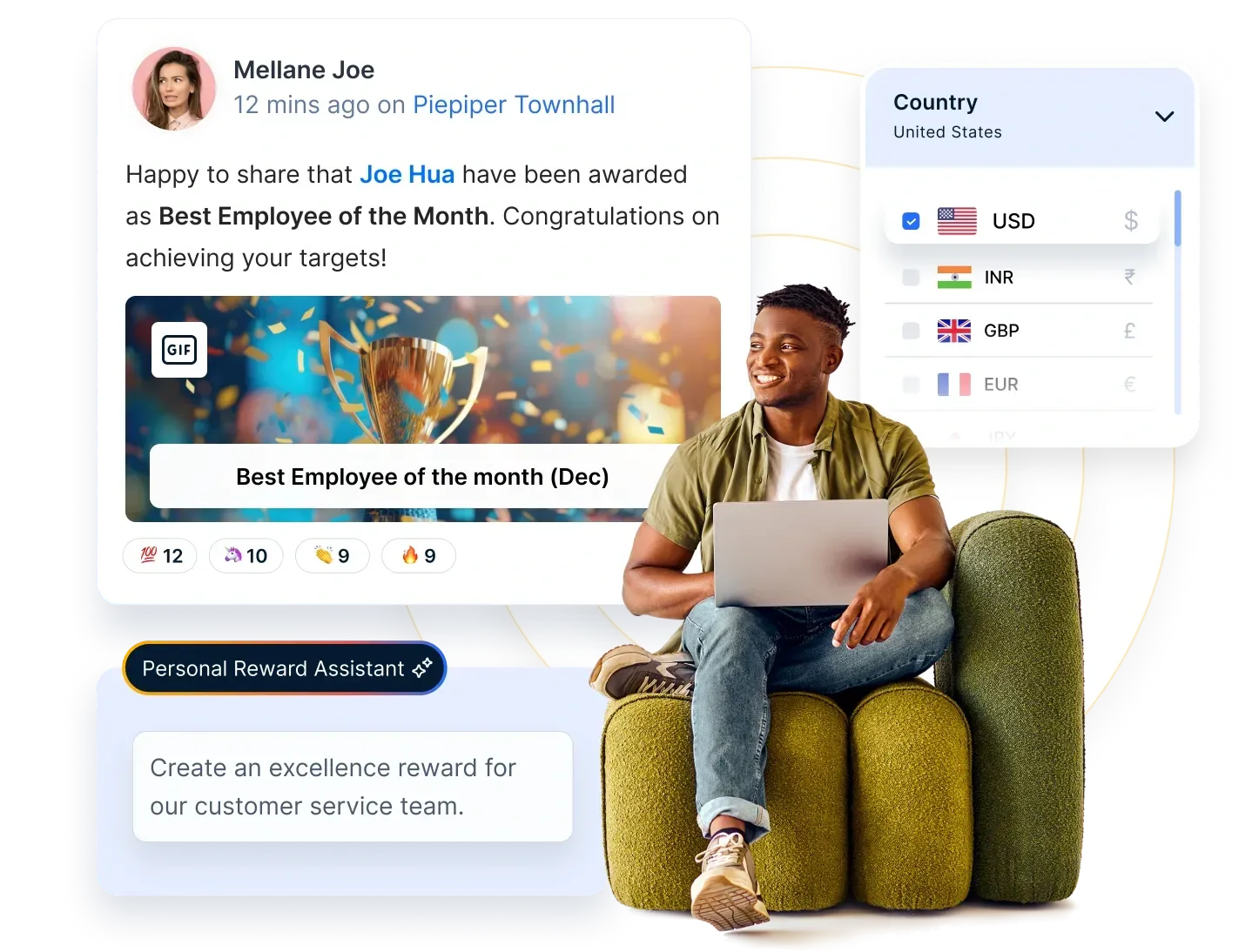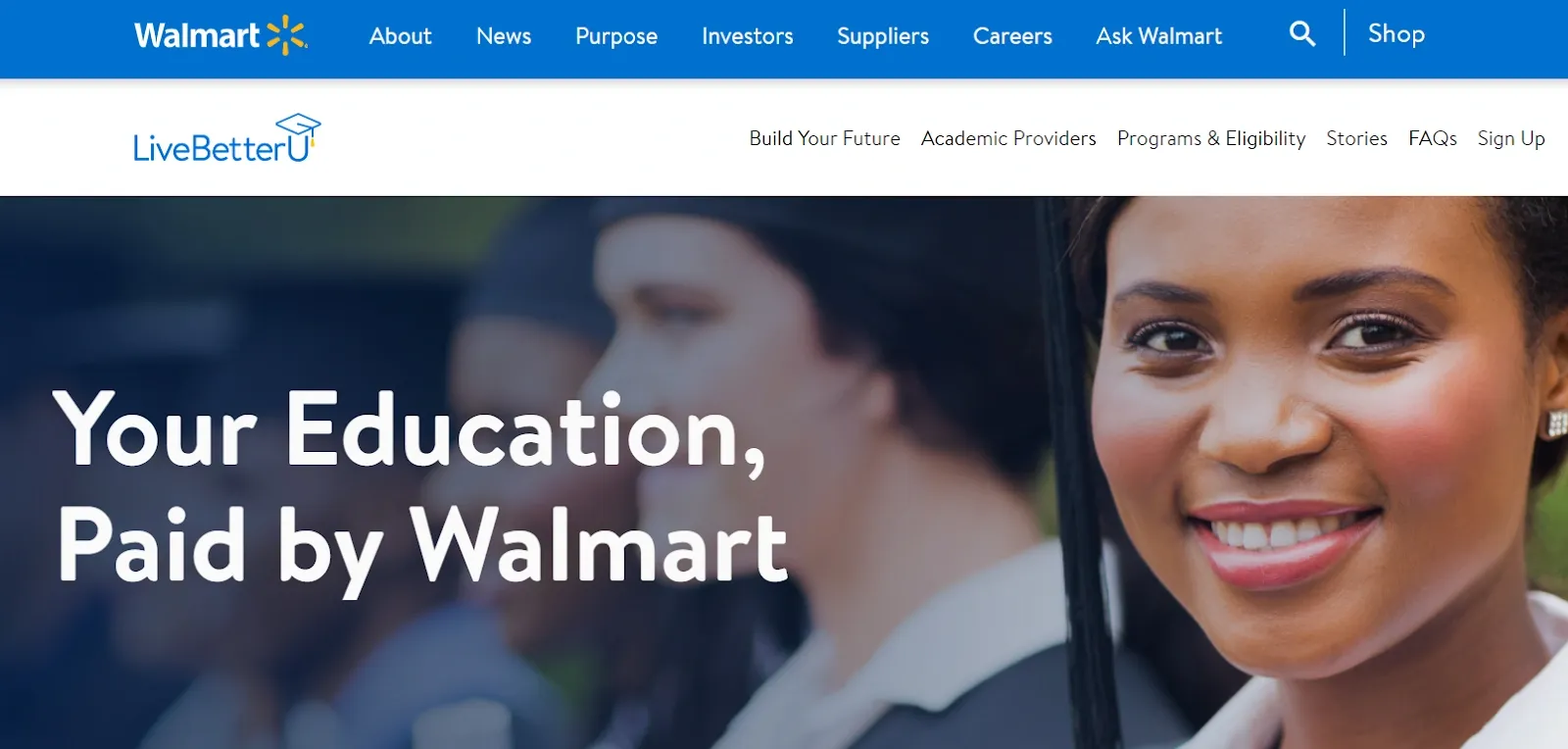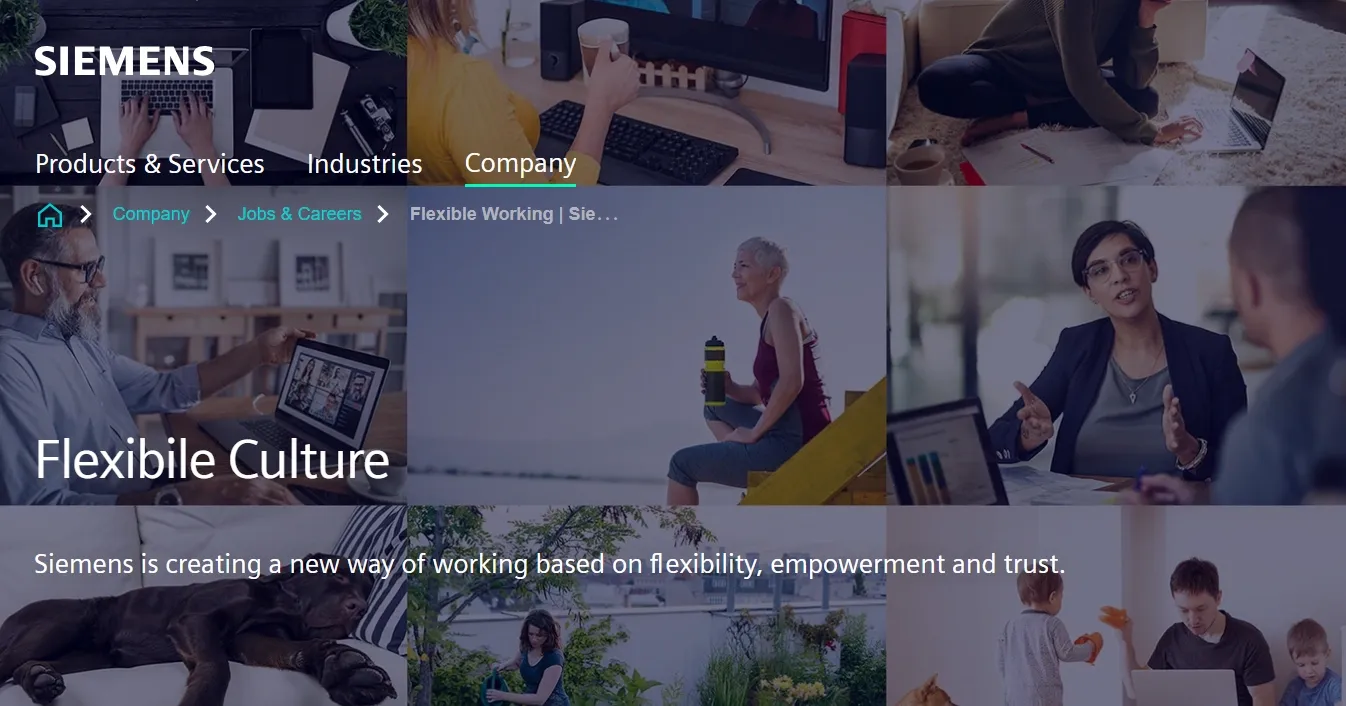Programa de retención de empleados e ideas de incentivos para conservar a sus mejores empleados
Explore poderosos incentivos para un programa de retención de empleados que mejore el compromiso, suba la moral y mantenga a sus mejores empleados comprometidos a largo plazo.
En esta página
- ¿Qué es un programa de retención de empleados?
- El papel de los incentivos en los programas de retención de empleados
- 15 ideas de incentivos para ejecutar programas eficaces de retención de empleados
- Empresas con los mejores programas de retención de empleados
- Crear una cultura de retención con Empuls
- Conclusión
- Preguntas frecuentes
Atraer a los mejores talentos es sólo la mitad de la batalla: mantenerlos comprometidos es el verdadero reto. Ante la creciente competencia por los empleados cualificados, las empresas deben invertir en programas de retención de empleados que fomenten la lealtad y la satisfacción laboral.
Una estrategia de retención bien estructurada va más allá del salario: implica crear un entorno de trabajo en el que los empleados se sientan valorados, apoyados y motivados para crecer. Los incentivos para retener a los empleados, como las primas por rendimiento, los beneficios para el bienestar y las oportunidades de desarrollo profesional, desempeñan un papel crucial en la reducción de la rotación y el fortalecimiento de la estabilidad de la plantilla.
Pero, ¿cuáles son los incentivos más eficaces para retener a los empleados? Desde los programas de reconocimiento hasta los acuerdos de trabajo flexible, este artículo explora estrategias probadas que ayudan a las organizaciones a retener a sus mejores talentos y construir un lugar de trabajo próspero.
Vamos a sumergirnos.
¿Qué es un programa de retención de empleados?
Un programa de retención de empleados es una estrategia estructurada diseñada para mantener a los empleados implicados, satisfechos y comprometidos con una organización a largo plazo. Estos programas se centran en reducir la rotación mejorando la cultura del lugar de trabajo, ofreciendo oportunidades de crecimiento y garantizando que los empleados se sientan valorados y apoyados.
Elementos clave de un programa eficaz de retención de empleados:
- Reconocimiento y recompensas: Reconocer las contribuciones de los empleados mediante incentivos, bonificaciones y plataformas como Empuls aumenta la motivación y la satisfacción laboral.
- Compensación y prestaciones competitivas: Ofrecer salarios justos, prestaciones sanitarias y beneficios complementarios libres de impuestos hace que sea menos probable que los empleados busquen oportunidades en otros lugares.
- Crecimiento y desarrollo profesional: Ofrecer formación, tutoría y trayectorias profesionales claras ayuda a los empleados a ver un futuro dentro de la organización.
- Iniciativas de conciliación de la vida laboral y familiar: Los acuerdos laborales flexibles, las opciones de trabajo a distancia y los programas de bienestar reducen el agotamiento y mejoran la retención general.
- Cultura de empresa y comunicación sólidas: Fomentar la transparencia, la colaboración y las opiniones de los empleados favorece el sentido de pertenencia y el compromiso.
Un programa de retención de empleados bien ejecutado no sólo reduce la rotación, sino que también mejora la productividad, la moral y el rendimiento general de la empresa. Las organizaciones que invierten en estrategias de retención crean un lugar de trabajo en el que los empleados quieren quedarse y crecer.
El papel de los incentivos en los programas de retención de empleados
Mantener a los empleados comprometidos y motivados es un reto constante para las empresas. Aunque la cultura de la empresa y las oportunidades de desarrollo profesional son importantes, los incentivos desempeñan un papel crucial para garantizar el compromiso de los empleados a largo plazo.
Ya se trate de primas monetarias, programas de reconocimiento o ventajas para el desarrollo profesional, los incentivos bien diseñados crean un lugar de trabajo en el que los empleados se sienten valorados y motivados.
Retener a los empleados no es sólo reducir la rotación: es fidelizarlos y fomentar un entorno de trabajo positivo. Los incentivos ayudan a:
- Aumenta la moral: Los empleados que se sienten valorados tienen más probabilidades de seguir motivados y ser productivos.
- Fomentar el rendimiento: Los incentivos basados en el rendimiento impulsan a los empleados a cumplir y superar sus objetivos.
- Mejora de la satisfacción laboral: Ventajas como los programas de bienestar o el tiempo libre remunerado adicional contribuyen a mejorar el equilibrio entre la vida laboral y personal.
- Fomentar la lealtad: Una sólida estructura de incentivos hace que los empleados se sientan valorados, lo que reduce la probabilidad de que busquen oportunidades en otros lugares.
- Reforzar la cultura de la empresa: Cuando los empleados son recompensados por sus contribuciones, es más probable que se comprometan con la visión y los valores de la empresa.

Construir un lugar de trabajo que los empleados no quieran abandonar
Retener a los mejores talentos no es sólo cuestión de salario, sino de crear un lugar de trabajo que les guste. Empuls te ayuda a fomentar el compromiso, recompensar las contribuciones y fortalecer las conexiones del equipo.
15 ideas de incentivos para ejecutar programas eficaces de retención de empleados
Naturalmente, a veces hay que hacer un esfuerzo activo para retener a los empleados. Poner en marcha incentivos para un programa de retención de empleados puede ser un enfoque eficaz, así que aquí tienes 15 ideas que deberías tener en cuenta.
1. Promociones internas
Sus empleados necesitan saber que, cuando llegue el momento, no traerá a otra persona para colocarla en un puesto directivo. Quieren que sea alguien de la plantilla. Incluso si no son ellos, al ascender a uno de sus compañeros, también les estás dando esperanzas de que esto pueda ocurrirles a ellos en algún momento.
2. Bonificaciones por rendimiento
Este punto es bastante sencillo y no requiere mucha explicación: si tus empleados hacen un gran trabajo, quieres recompensarles económicamente. La diferencia entre una prima de rendimiento y una paga es que ellos esperan y sienten que merecen esta última, por lo que no sienten gratitud por ella. Las primas se ven de otra manera.
3. Descuento para empleados
Si sus empleados son también clientes suyos, puede ofrecerles un descuento especial. De este modo, también podrían ganar crédito social porque pueden pedir un artículo para su amigo o familiar utilizando su descuento.
4. Días adicionales de vacaciones
Al igual que con las primas, ya tienen derecho a sus días de vacaciones, pero ¿qué te parece darles unos días más para recompensarles por su comportamiento ejemplar y su admirable rendimiento? Es poco para ti, pero podría marcar la diferencia para ellos.
5. Aniversarios laborales
Al cabo de un tiempo, sus empleados pueden tener la sensación de que no les tiene en cuenta. ¿Por qué no organizar una fiesta de aniversario e incluso comprarles un regalo para demostrarles que no es así?
6. Participación en los beneficios
¿Por qué van a preocuparse tus empleados por el resultado de un proyecto si trabajan a sueldo? Independientemente de si el proyecto tiene éxito o fracasa, sus ingresos no se ven afectados. Claro que la reputación de la empresa y la salud a largo plazo también les afectan, pero esto es demasiado abstracto y está demasiado lejos en el futuro. En su lugar, empieza a basar sus primas en el porcentaje de beneficios.
7. Dándoles acciones de su empresa
Al recompensar a sus empleados leales con acciones de su empresa, les está dando una razón para esforzarse más. Una de las formas más incentivadoras de enfocar esto es dar a sus empleados un sentido de propiedad en la empresa. De este modo, no es sólo un sentido; les estás dando una participación.
8. Programas de desarrollo profesional
La gente suele dejar su empleo porque no cree que tenga futuro en su empresa. Sin embargo, si tuvieran una hoja de ruta para su desarrollo profesional, no tendrían tantas ganas de marcharse.
9. Actos sociales patrocinados por la empresa
Las actividades de creación de equipos tienen su utilidad, pero para la mayoría de los miembros de su plantilla no son más que una excusa para que el equipo se divierta. Así que considera la posibilidad de llevar a tu equipo al paintball o a una escape room para estrechar lazos.
10. Programa de recomendación de empleados
Siempre que haya una vacante, pide a tus empleados que recomienden a alguien. Esto les demostrará que valoras su opinión y, al igual que con el descuento, es una gran oportunidad para que ganen algunos puntos sociales.
11. 11. Proyectos especiales
Algunas personas abandonan a sus jefes porque no se sienten retadas. Así que, siempre que sientas que alguien no ha sido "retado" durante demasiado tiempo, cámbialo a un proyecto o tarea especial.
12. Modalidades de trabajo flexibles
Ahora bien, esto es diferente de dar a todo el mundo un horario de trabajo especial. ¿Por qué alguien se sentiría especial/agradecido por ello si es tu modelo de negocio estándar? En lugar de eso, puedes conceder "privilegios" de flexibilidad laboral a las personas.
13. Programas de bienestar para empleados
Ir más allá y ofrecer privilegios especiales a sus empleados es una forma estupenda de demostrarles que se preocupa por ellos. Ser socio de un gimnasio, de un centro de yoga o de una biblioteca no es tan caro, pero tiene un importante efecto psicológico en el personal.
14. Mejoras del seguro de enfermedad
La calidad de su programa de seguro médico puede demostrar que realmente le importa y que merece la pena que uno siga a su servicio. Una póliza estándar es más de lo que ofrecen algunos lugares de trabajo, pero ir más allá siempre tendrá un impacto más profundo.
15. Oportunidades de tutoría
A la gente le gusta trabajar con expertos, lo cual es increíblemente beneficioso para sus planes de carrera. Así que, si contratas a personas reputadas y a expertos del sector, el resto de tu plantilla podría sentirse incentivada a quedarse un tiempo más.
Empresas con los mejores programas de retención de empleados
Las mejores empresas del mundo dan prioridad a mantener a sus empleados contentos y comprometidos. Han puesto en práctica estrategias específicas para mejorar la retención, y aquí tienes cinco ejemplos claros para inspirarte:
1. Apoyar la formación continua, como Walmart

Los empleados pueden marcharse para ampliar sus estudios, lo que puede suponer una pérdida para la empresa. Si apoyas sus objetivos educativos, podrás mantenerlos a bordo.
El enfoque de Walmart: Se asocian con universidades para ofrecer cursos universitarios con descuento. La formación continua es vital para la retención de los empleados de Walmart, con un 70% de los empleados que han recibido formación permanecen más tiempo que los que no.
Impacto: La empresa experimentó una reducción del 30% en los índices de rotación de personal en las áreas con programas de mejora de las cualificaciones, lo que pone de relieve la relación entre el desarrollo de los empleados y la mejora de la retención.
2. Utiliza vistas previas de puestos de trabajo realistas, como Hoteles Hilton

Cuando los empleados tienen expectativas de trabajo poco realistas, es probable que se marchen antes de tiempo. Un plan de trabajo realista ayuda a establecer expectativas precisas desde el principio.
El enfoque de Hilton: El programa "Pasaporte al éxito" de Hilton mejoró la retención de los empleados, alcanzando un 96% de retención y una tasa de promoción del 40% entre el personal formado en un plazo de seis meses.
Impacto: El éxito del programa, que incluyó la formación de más de 15.000 empleados y la duplicación de su alcance con módulos en línea, pone de relieve cómo el desarrollo de competencias específicas mejora la fidelidad y el crecimiento profesional.
3. Fomentar un entorno de trabajo flexible, como Siemens

Un entorno de trabajo propicio es crucial para la retención. Los empleados tienen necesidades diferentes, como los padres primerizos que necesitan tiempo libre o alguien que quiere trabajar a distancia.
El enfoque de Siemens: Tienen una política de flexibilidad dirigida por los empleados (ELF), que permite el trabajo a tiempo parcial y las opciones a distancia sin un largo proceso de aprobación. Esto ayuda a los empleados a conciliar el trabajo con su vida personal.
Impacto: Una encuesta de FlexJobs reveló que 80% de los empleados serían más fieles a sus empresas si dispusieran de opciones de trabajo flexibles.
4. Comunicarse en tiempos difíciles, como Gucci
Las crisis económicas pueden hacer que los empleados se preocupen y se marchen. Una comunicación y un apoyo claros pueden evitarlo.
El enfoque de Gucci: Durante una desaceleración de las ventas, el CEO tranquilizó a los empleados a través de un mensaje de vídeo, animándoles a mantenerse positivos y centrados. Esta transparencia ayudó a mantener la confianza y la moral.
Impacto: Marco Bizzarri, Consejero Delegado de Gucci, tranquilizó a los empleados durante una desaceleración del crecimiento de las ventas, lo que probablemente contribuyó a mantener la moral y la lealtad. Los estudios demuestran que las empresas con empleados comprometidos aumentan su rentabilidad en un 21% y reducen la rotación en un 59%. un 59% menos de rotación. A pesar de que el crecimiento de Gucci se ralentizó del 48,7% al 40,1%, la comunicación de Bizzarri probablemente reforzó la confianza y la retención de los empleados.
Estas sencillas estrategias demuestran que mantener a los empleados contentos y comprometidos va más allá del salario y las prestaciones. Ofreciendo trayectorias profesionales claras, apoyando la formación, fijando expectativas laborales realistas, ofreciendo opciones de trabajo flexibles y manteniendo una comunicación abierta, puede crear un entorno de trabajo en el que los empleados se sientan valorados y motivados para quedarse.
Crear una cultura de retención con Empuls

Retener a los empleados no es sólo cuestión de salarios competitivos o ventajas ocasionales, sino de crear un entorno en el que los empleados se sientan valorados, motivados y conectados. Un sólido programa de retención de empleados garantiza que el compromiso y el reconocimiento formen parte de la cultura laboral diaria.
Aquí es donde Empuls marca la diferencia. Al integrar recompensas, reconocimiento y feedback en tiempo real en una única plataforma, ayuda a las empresas a crear un lugar de trabajo en el que los empleados se sientan apreciados e inspirados para quedarse.
- Reconocimiento y recompensas continuos: celebre los logros, los hitos y las contribuciones diarias con incentivos personalizados que realmente importan.
- Comentarios de los empleados en tiempo real: conozca los niveles de compromiso y recopile información con encuestas de opinión y análisis de opiniones para abordar los problemas antes de que se agraven.
- Reconocimiento entre iguales sin fisuras: fomente una cultura de agradecimiento permitiendo a los empleados reconocerse y recompensarse mutuamente sin esfuerzo.
- Incentivos y beneficios personalizados - Ofrezca recompensas flexibles que se ajusten a las preferencias de los empleados, garantizando que cada momento de reconocimiento sea significativo.
- Conexiones más fuertes en el lugar de trabajo: fomente la unión y la colaboración en equipo a través de funciones de participación social, ayudando a los empleados a sentirse más conectados con la organización.
La retención no consiste sólo en reducir la rotación, sino en mantener a los empleados comprometidos y motivados para que den lo mejor de sí mismos. Empuls ayuda a las organizaciones a crear una cultura en la que los empleados eligen quedarse, crecer y prosperar.
Conclusión
La retención de empleados es fundamental para las organizaciones que buscan mantener la productividad, la moral y la continuidad. Los programas de retención eficaces reducen los costes de rotación y fomentan una plantilla leal y motivada.
Las organizaciones pueden mejorar significativamente la satisfacción y la lealtad de sus empleados mediante la incorporación integral, el aprendizaje y el desarrollo continuos, el reconocimiento y las recompensas, la flexibilidad laboral, los programas de bienestar para empleados y una sólida cultura de empresa.
Ejemplos de empresas estadounidenses líderes como Google, AT&T, Adobe, Microsoft y Johnson & Johnson demuestran el éxito de estas estrategias.
Al invertir en el crecimiento profesional y el bienestar de los empleados, las empresas pueden crear un entorno de trabajo propicio y atractivo, lo que se traduce en mayores tasas de retención y en el éxito general de la organización.
Preguntas frecuentes
1. ¿Cómo influyen el aprendizaje y el desarrollo continuos en la retención?
Ofrecer oportunidades de aprendizaje y desarrollo continuos ayuda a los empleados a sentirse valorados e implicados, lo que aumenta su probabilidad de permanecer en la empresa. Por ejemplo, la iniciativa Future Ready de AT&T ofrece una amplia formación, lo que se traduce en una plantilla más cualificada y leal.
2. ¿Qué papel desempeñan los programas de reconocimiento y recompensa en la retención?
Los programas de reconocimiento y recompensa aumentan la moral y la lealtad de los empleados. Por ejemplo, el programa "Check-in" de Adobe, que sustituye las revisiones anuales por comentarios continuos, ha conseguido una plantilla más comprometida y una tasa de rotación un 31 % menor.
3. ¿Cómo influyen los acuerdos de trabajo flexible en la retención de los empleados?
Los acuerdos de trabajo flexible, como el trabajo a distancia y los horarios flexibles, influyen significativamente en la satisfacción y la retención de los empleados. Las amplias opciones de trabajo flexible de Microsoft han demostrado que el 80% de los empleados serían más leales si dispusieran de ellas.
4. ¿Cómo afecta una cultura empresarial sólida a la retención de los empleados?
Una cultura empresarial sólida que se alinee con los valores de los empleados fomenta el sentido de pertenencia y la lealtad. El énfasis de Patagonia en la sostenibilidad medioambiental y la responsabilidad corporativa ha creado un entorno de trabajo positivo, mejorando significativamente la retención.
5. ¿Cuáles son algunas ideas más sencillas para fomentar la retención de los empleados?
Entre las estrategias más sencillas cabe citar el apoyo a la formación continua (por ejemplo, la asociación de Walmart con universidades), la oferta de ofertas de empleo realistas (por ejemplo, el programa "Pasaporte al éxito" de Hilton), el fomento de un entorno de trabajo flexible (por ejemplo, la política ELF de Siemens) y la comunicación en tiempos difíciles (por ejemplo, la tranquilidad del CEO de Gucci durante la desaceleración de las ventas).













